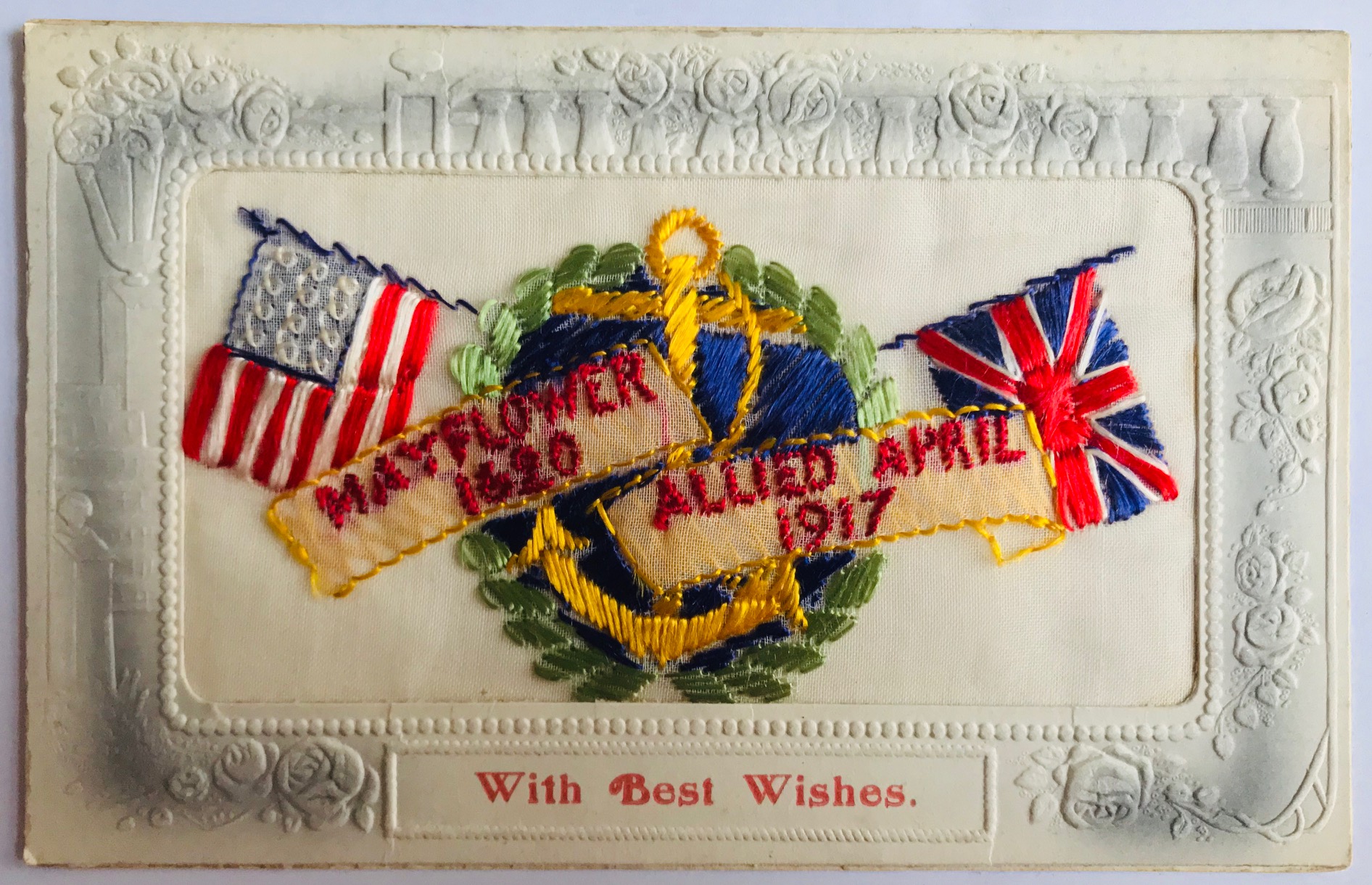This embroidered silk postcard commemorated the official entry of the USA into the First World War. It was made in England by Birn Brothers, Ltd – a large printing house that manufactured both cheap pictorial books and postcards.[1] On the front of the postcard, the Stars and Stripes and the Union Jack hang out from behind a laurel wreath and an anchor: symbols of nationhood, victory and naval power intertwined. Joining the composition together are two pennants adorned with ‘Mayflower 1620’ and ‘Allied April 1917’. Mayflower-mania had been reaching fever pitch on both sides of the Atlantic in the final years of the 19th century and especially in the lead-up to the First World War. New editions of important fiction and non-fiction works about the Pilgrim Fathers were published, monuments erected in towns and cities that linked themselves to the story, and committees formed to plan largescale celebrations for the 300th anniversary in 1920. Around the same time, a rapprochement between Britain and the USA was taking place after a long period of animosity following the American Revolution. To achieve the sense of a new alliance, diplomats – from the highest echelons of government to the everyday Anglo-American enthusiast – actually looked back to history. The tale of the Pilgrim Fathers was ripe for using as a tool to create a shared identity. ‘The return of the Mayflower’ had already become a familiar expression in previous decades, referring to the 1621 return voyage on which no Pilgrims had chosen to journey. But during the War the phrase took on a new meaning: the return in the present of now-American Pilgrims to save their mother country. Rudyard Kipling popularised this idea in 1917 when he described how the world had seen ‘The second sailing of the Mayflower’ and tentatively asked ‘What shall grow out of her return voyage our grandchildren may, perhaps, comprehend.’[2] In a bright and colourful way, this postcard captured that spirit.
[1] Metro Postcard – http://www.metropostcard.com/publishersb1.html
[2] Rudyard Kipling, ‘The second sailing of the “Mayflower”’, Daily Telegraph (August 17th 1918).


I am very interested in Anglo American relations and was fascinated by your postcard. We have a small family charity that supports Anglo American scholarships.
I am the author of a recently published book which features memorabilia from the 1950s. Postcards, plates, ties, medallions and much more to raise money to build Mayflower II. The book is called The Wicked Pilgrim and it is the story of how my father gave the ship to America to thank them for their support in two World Wars.
Go to http://www.thewickedpilgrim.com
Hi Randal!
I am glad you found the postcard interesting! Testament to the commemorative symbolic power that the Mayflower had in Anglo-American circles in the 20th century – power that was still exerting influence in the 1950s, as you rightly say! I’ve actually bought your book (just waiting for it to arrive) because I’m currently researching the Mayflower II – I’ll be putting a full feature on the voyage in the next couple of months. Meanwhile, you might like this short blog about a souvenir taken on the Mayflower II – maybe it’s one you’ve seen before?! http://voyagingthroughhistory.exeter.ac.uk/2020/02/07/getting-tipsy-on-the-mayflower-ii/
Tom